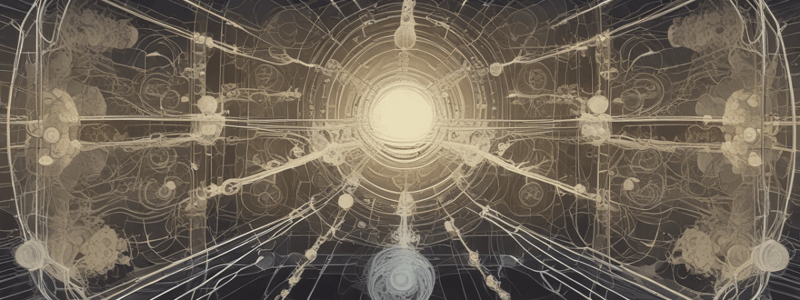Podcast
Questions and Answers
What happens to blood flow to the peripheries when body temperature returns to normal after being elevated?
What happens to blood flow to the peripheries when body temperature returns to normal after being elevated?
- Blood flow to the peripheries remains constant.
- Blood flow to the peripheries returns to normal. (correct)
- Blood flow increases above normal levels.
- Blood flow decreases significantly.
Which type of feedback mechanism is mainly used for homeostatic controls in the body?
Which type of feedback mechanism is mainly used for homeostatic controls in the body?
- Negative feedback mechanisms. (correct)
- Cascade systems.
- Positive feedback mechanisms.
- Amplifier systems without feedback.
In a positive feedback mechanism, how does the response to a stimulus typically change?
In a positive feedback mechanism, how does the response to a stimulus typically change?
- It diminishes over time.
- It remains unchanged.
- It eventually reaches a maximum and then stops.
- It progressively increases. (correct)
What role does the hormone oxytocin play during labor?
What role does the hormone oxytocin play during labor?
What results when homeostatic control systems are unable to maintain balance?
What results when homeostatic control systems are unable to maintain balance?
How does the body respond to the stretching of the cervix during labor?
How does the body respond to the stretching of the cervix during labor?
What is the effect of increased body temperature on temperature-sensitive nerve endings?
What is the effect of increased body temperature on temperature-sensitive nerve endings?
What primarily differentiates positive feedback mechanisms from negative feedback mechanisms?
What primarily differentiates positive feedback mechanisms from negative feedback mechanisms?
What is the primary purpose of negative feedback mechanisms in the body?
What is the primary purpose of negative feedback mechanisms in the body?
In the analogy of a domestic central heating system, what role does the thermostat play?
In the analogy of a domestic central heating system, what role does the thermostat play?
Which mechanism is activated when body temperature falls below the preset level?
Which mechanism is activated when body temperature falls below the preset level?
What happens when the thermostat detects that the room temperature has reached the preset level?
What happens when the thermostat detects that the room temperature has reached the preset level?
How does narrowing blood vessels in the skin help regulate body temperature?
How does narrowing blood vessels in the skin help regulate body temperature?
Which of the following is NOT a mechanism to raise body temperature when it falls?
Which of the following is NOT a mechanism to raise body temperature when it falls?
What does the process of negative feedback primarily achieve in physiological systems?
What does the process of negative feedback primarily achieve in physiological systems?
What role do specialized temperature-sensitive nerve endings in the hypothalamus serve?
What role do specialized temperature-sensitive nerve endings in the hypothalamus serve?
Flashcards are hidden until you start studying
Study Notes
Negative Feedback Mechanisms
- Negative feedback mechanisms decrease or negate the effect of the original stimulus to maintain homeostasis.
- Body temperature regulation serves as a physiological example of negative feedback, similar to a central heating system.
- A thermostat detects room temperature changes and sends information to the boiler control unit, which acts as the control center and effector.
- When room temperature drops below a preset level, the thermostat activates the boiler to produce heat.
- Once the desired temperature is achieved, the thermostat turns off the boiler, allowing the room to cool gradually.
- Body temperature control involves temperature-sensitive nerve endings in the hypothalamus, acting as a control center.
- Mechanisms to raise body temperature include shivering, narrowing blood vessels, and behavioral changes (e.g., wearing more clothes).
- Negative feedback mechanisms continuously self-regulate various physiological variables, preventing extreme changes in the internal environment.
Positive Feedback Mechanisms
- Positive feedback mechanisms amplify the response progressively rather than negate it.
- Blood clotting and uterine contractions during labor are key examples of positive feedback.
- During labor, oxytocin stimulates uterine contractions, which push the baby's head into the cervix and activate stretch receptors.
- The activation of stretch receptors leads to further release of oxytocin, intensifying contractions and maintaining labor.
- Once the baby is delivered, the stimulus ceases, halting oxytocin release.
Homeostatic Imbalance
- Homeostatic imbalance occurs when control of a variable factor is inadequate, leading to levels outside the normal range.
- Failure to maintain homeostasis can result in abnormal states that threaten health or life.
- Various factors contributing to homeostatic imbalances are detailed in subsequent chapters.
Studying That Suits You
Use AI to generate personalized quizzes and flashcards to suit your learning preferences.




